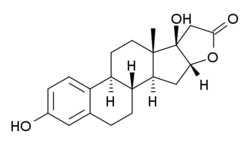Chemistry:16α-LE2
 | |
| Identifiers | |
|---|---|
| |
| CAS Number | |
| ChemSpider | |
| UNII | |
| Chemical and physical data | |
| Formula | C20H24O4 |
| Molar mass | 328.408 g·mol−1 |
| 3D model (JSmol) | |
| |
| |
16α-LE2, or 16α-lactone-estradiol, also known as 3,17β-dihydroxy-19-nor-17α-pregna-1,3,5-(10)-triene-21,16α-lactone, is a synthetic, steroidal estrogen featuring an estradiol core. It is a highly potent and selective agonist of the ERα that is used in scientific research to study the function of the ERα.[1][2] It has 265-fold higher potency in transactivation assays of the ERα relative to the ERβ and 70-fold preference in binding affinity for the ERα over the ERβ.[2]
In rodents, 16α-LE2 has no effect on ovarian follicle development, whereas the highly ERβ-selective agonist 8β-VE2 stimulates follicular growth and to a comparable extent as estradiol, indicating that the ERβ and not the ERα is involved in the effects of estrogen on ovarian follicles.[2][3] In contrast, 16α-LE2 stimulates uterine weight, whereas 8β-VE2 has no effect, indicating that the ERα and not the ERβ is involved in the effects of estrogen on the uterus.[2] Research has determined through experimental rodent studies with estradiol, 16α-LE2, and 8β-VE2 that the positive, protective effects of estrogens on bone formation resorption and bone mineral density are mediated via the ERα, whereas the ERβ does not appear to be involved.[4]
See also
- ERA-45
- ERA-63
- Propylpyrazoletriol
- Methylpiperidinopyrazole
- GTx-758
- Diarylpropionitrile
- WAY-200070
- 16α-Iodo-E2
References
- ↑ "Mechanisms of action of particular endocrine-disrupting chemicals". Endocrine-Disrupting Chemicals in Food. Elsevier. 31 March 2009. pp. 550–. ISBN 978-1-84569-574-3. https://books.google.com/books?id=x6ejAgAAQBAJ&pg=PA550.
- ↑ 2.0 2.1 2.2 2.3 "Impact of isotype-selective estrogen receptor agonists on ovarian function". Proceedings of the National Academy of Sciences of the United States of America 101 (14): 5129–5134. April 2004. doi:10.1073/pnas.0306720101. PMID 15037755. Bibcode: 2004PNAS..101.5129H.
- ↑ "Steroid Receptors in the Uterus and Ovary". Knobil and Neill's Physiology of Reproduction. Academic Press. 15 November 2014. pp. 1150–. ISBN 978-0-12-397769-4. https://books.google.com/books?id=I1ACBAAAQBAJ&pg=PA1150.
- ↑ "Estrogen receptor subtype-specific effects on markers of bone homeostasis". Molecular and Cellular Endocrinology 291 (1–2): 104–108. September 2008. doi:10.1016/j.mce.2008.03.003. PMID 18433985. https://hal.archives-ouvertes.fr/hal-00532015/file/PEER_stage2_10.1016%252Fj.mce.2008.03.003.pdf.
 |
